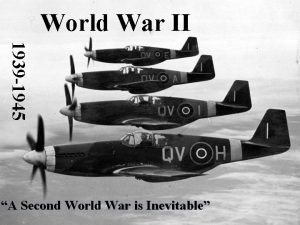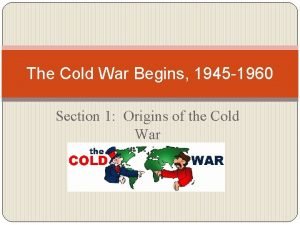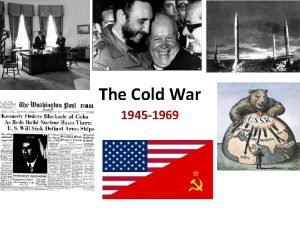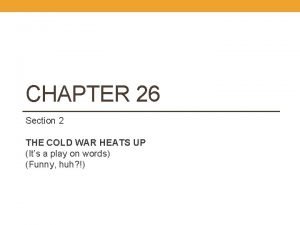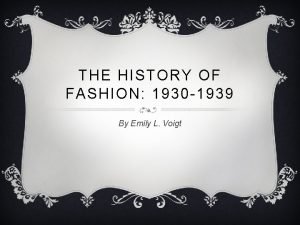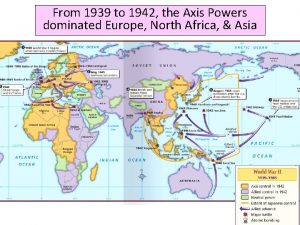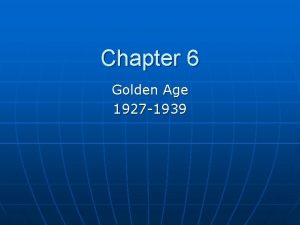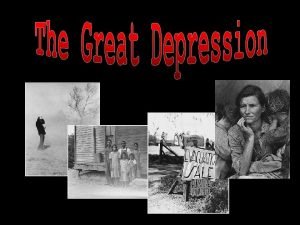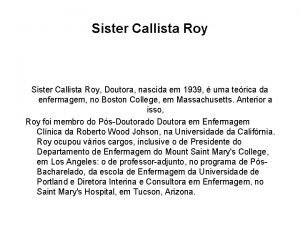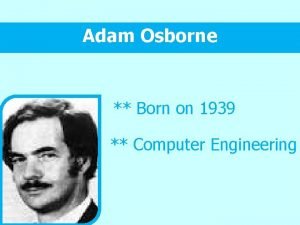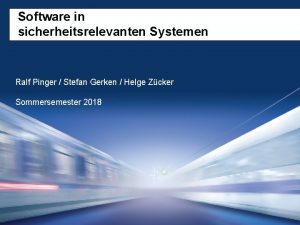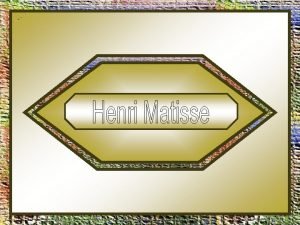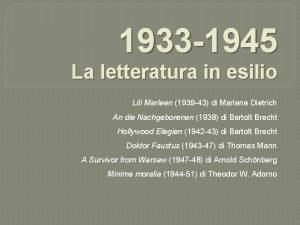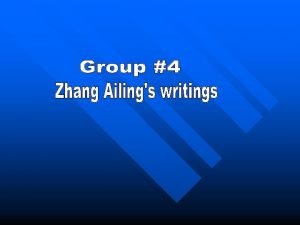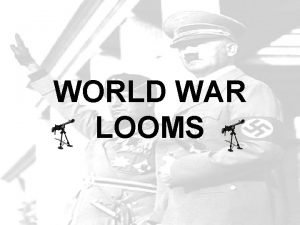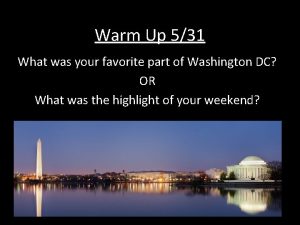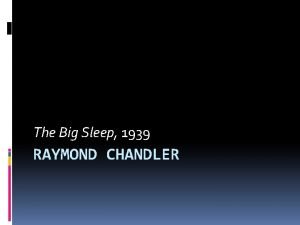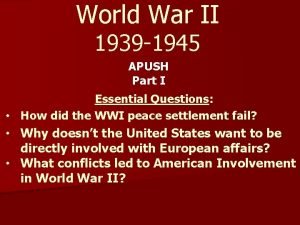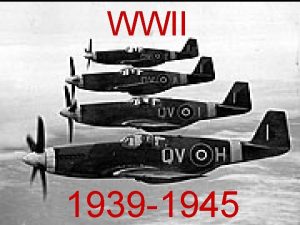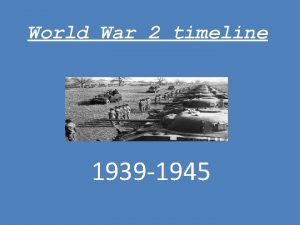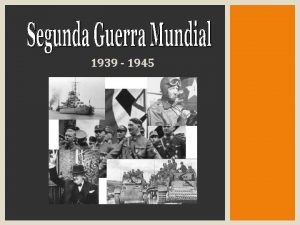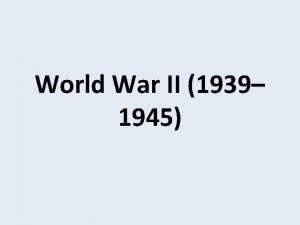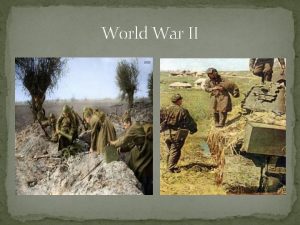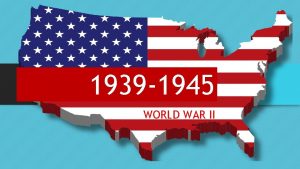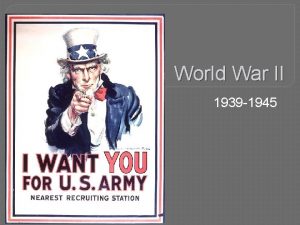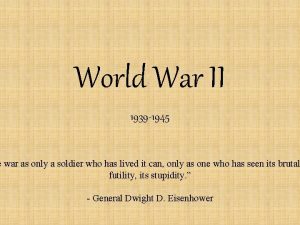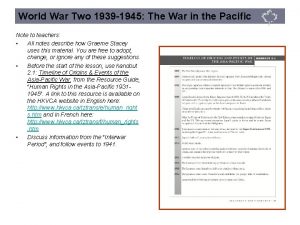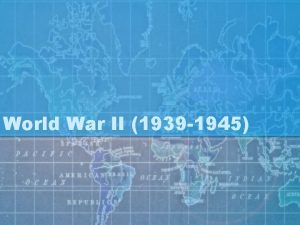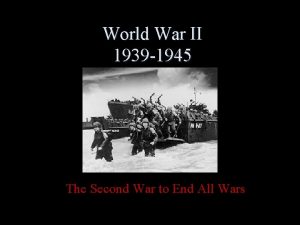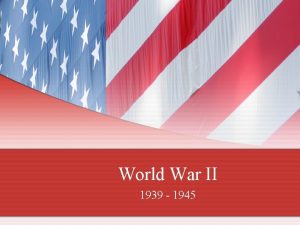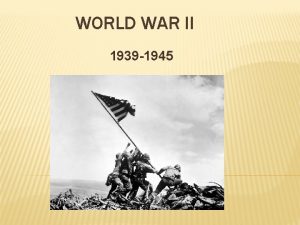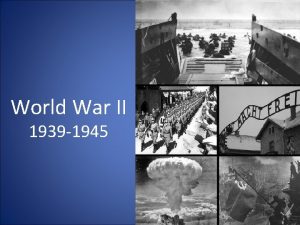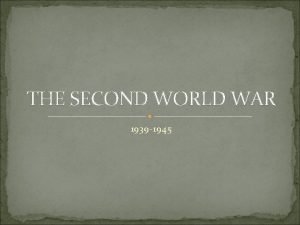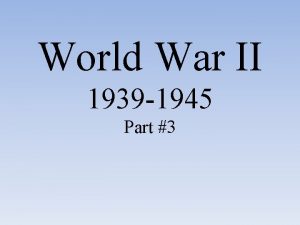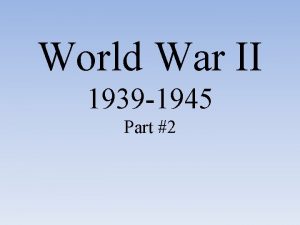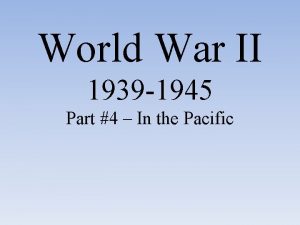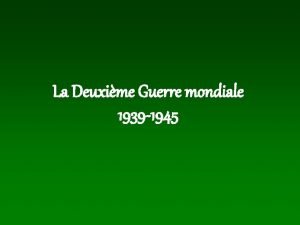World War II 1939 1945 APUSH Part II



























- Slides: 27

World War II 1939 -1945 APUSH Part II

Allied vs. Axis Powers • Allied Powers: Great Britain, France, USA, Soviet Union • Axis Powers: Germany, Italy, Japan

Selective Service • U. S. Fought WWII in two fronts; Atlantic & Pacific • 5 million volunteers not enough to effectively wage war • Selective Service added 10 million soldiers • What was the role of women & minorities in the war effort?

Women in WWII • Women’s Auxiliary Army Corps (WAAC) • Allowed women volunteers to join the military and serve in non-combat positions • How did women help out on the home front during WWII? • Took over jobs left behind by men

Minorities & WWII • WWII created problems in armed forces • As minorities rushed to enlist the military was pressured to end discrimination & segregation • Despite poor treatment many minority groups continued to serve in U. S. Military

A. Philip Randolph • Organized march on Washington to protest discrimination in military & industry • Met with FDR who issued order for end of discrimination in industry • Why was it so important to end discrimination in industry during WWII?

Industry during WWII • Many African. Americans & women work industrial jobs for the first time • Support for war time industries just as important as support for war itself • Women and Minorities proved they are just as capable in factory work as white men “Rosie the Riveter”

Economic Conversion • Economy must shift to totally support war effort • Factories converted to war production • Mechanical pencils = bomb parts • Bedspreads = mosquito nets • Less chrome on cars • Increased ship building

Rationing & Price Controls • Rationing of rare goods to conserve resources during WWII • Meat, sugar, coffee • Shoes, metal, gasoline • Price controls to stop inflation • War Production Board (WPB) Rationed fuel & materials vital to war effort • Office of Price Administration (OPA) fought wartime inflation by freezing wages, prices and rent

Japanese Internment • After Pearl Harbor many innocent Japanese Americans are sent to internment camps • Hypocritical? • Many Americans falsely thought Japanese immigrants were spies • 110, 000 Japanese Americans put in 10 “relocation centers”, mostly on the West Coast

German Blitzkrieg • Nazi military Strategy, quick moving military attacks • Based on surprise and use of overwhelming force

Battle for the Atlantic • Hitler order’s U-boat attacks on U. S. ships • Hitler’s goal was to cut off Europe from U. S. supplies • Allies use convoy ships with sonar to defeat Axis powers and take control of Atlantic

D-Day • June 6, 1944 • Began the Battle of Normandy • 3 million allied troops invade Nazi controlled Northern France • Commanded by Dwight D. Eisenhower • Land-Sea-Air assault • Allies liberate France from German control

Allied troops landing at Normandy

The Fall of Berlin • April of 1945 the Soviet Army marches into Berlin, Germany’s capital • German citizens and the gov’t panicked • Hitler commits suicide • May 8, 1945 Allies celebrate V-E day • FDR dies on April 12, 1945

War in the Pacific • Early on Japan dominate the Pacific WWII theater • U. S. Navy is devastated from surprise attack on Pearl Harbor • Battle of Midway is the turning point • Allies slowly begin to take territory back from Japanese & move closer to Japan

Battle of Midway June 3, 1942 • Turning point in the Pacific War • Allies break Japanese code & knew the small island of Midway was next target • Caught Japanese off guard & destroyed 4 aircraft carriers and 250 combat planes

• How does the United States end WWII in the Pacific? • What are the scientific, economic, and military implications of using nuclear warfare?

The Atomic Bomb • Dropped Hiroshima & Nagasaki, Japan • Why did U. S. feel forced to use nuclear weapons? • Why was FDR not apart of this process? • Who became President after FDR died? Harry Truman • 200, 000 people die in Japan

WWII Propaganda • For each poster answer the following two questions: • Who is the poster’s target audience? • Most important/appealing aspect of the poster • After viewing all the posters answer the following question: • Which Poster is most effective in getting its message across?


WWII Propaganda

WWII Propaganda

WWII Propaganda

WWII Propaganda

WWII Propaganda

WWII Propaganda
 1945 world war ii
1945 world war ii 1945 world war
1945 world war The cold war begins 1945-1960
The cold war begins 1945-1960 The cold war heats up: 1945 - 1969
The cold war heats up: 1945 - 1969 The cold war heats up: 1945 - 1969
The cold war heats up: 1945 - 1969 Ann arbor mi population pyramid
Ann arbor mi population pyramid Fashion 1930 to 1940
Fashion 1930 to 1940 Revolutionary leaders 1900-1939
Revolutionary leaders 1900-1939 Poland population 1939
Poland population 1939 Varför kallas perioden 1918-1939 för mellankrigstiden
Varför kallas perioden 1918-1939 för mellankrigstiden The golden age (1939-1956)
The golden age (1939-1956) Harta germaniei 1939
Harta germaniei 1939 Who dominated europe, north africa and asia from 1939-1942?
Who dominated europe, north africa and asia from 1939-1942? Golden age of aviation 1927-1939
Golden age of aviation 1927-1939 1939 market crash
1939 market crash Mapamundi 1939
Mapamundi 1939 Casablanca film noir
Casablanca film noir 18. testu iruzkina
18. testu iruzkina Teoria de callista roy slides
Teoria de callista roy slides Computer 1939
Computer 1939 Bahn signallampe 1939
Bahn signallampe 1939 Henri matisse la musique 1939
Henri matisse la musique 1939 Lili marleen 1939
Lili marleen 1939 Eileen chang love in a fallen city summary
Eileen chang love in a fallen city summary St. louis ship 1939
St. louis ship 1939 September 3, 1939
September 3, 1939 Toplumla sosyal hizmet uygulama modelleri
Toplumla sosyal hizmet uygulama modelleri Raymond chandler 1939
Raymond chandler 1939
